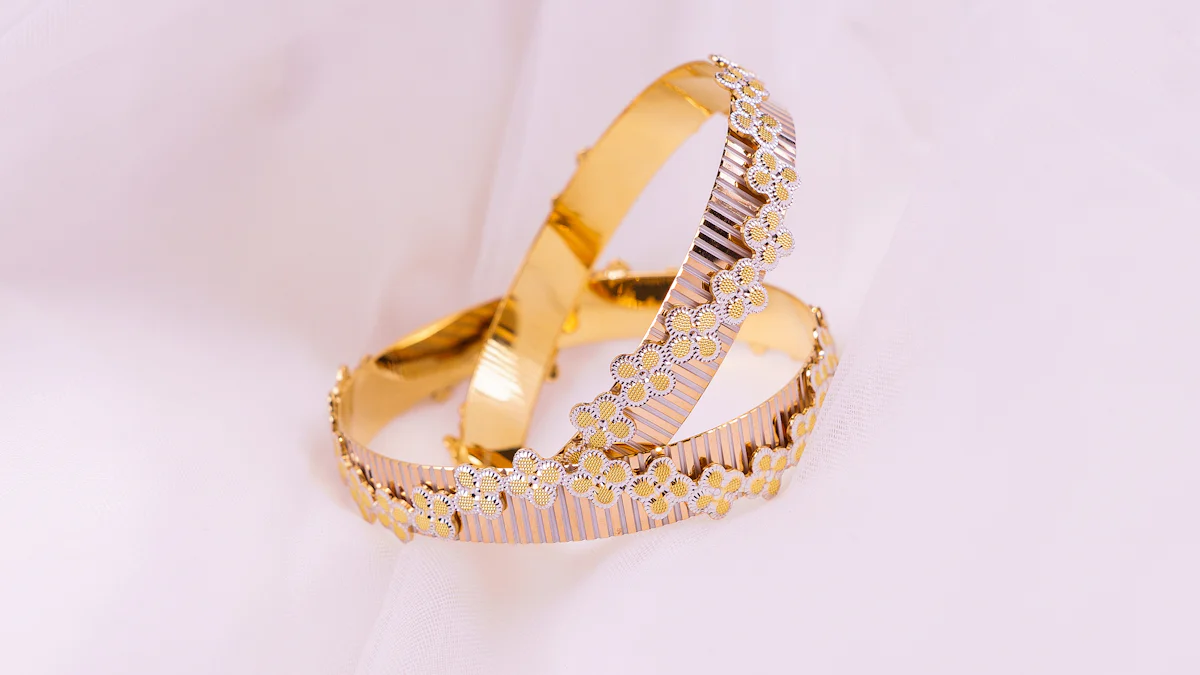Decoding Gold Karats for Purity

Gold karats play a crucial role in determining the purity of gold jewelry. Understanding what is a karat helps you assess the authenticity and value of your gold possessions. Each karat level indicates a specific percentage of pure gold, affecting the appearance, durability, and market value of the jewelry. By grasping the significance of gold purity, you can make informed decisions when purchasing or investing in gold. This knowledge ensures you choose the right type of gold that matches your preferences and needs.
What is a Karat?
Definition of Karats
The term "karat" refers to a unit of measurement that indicates the purity of gold. The karat system measures gold purity on a scale from 1 to 24. When you hear about 24-karat gold, it means the gold is pure, with no other metals mixed in. This system helps you understand how much pure gold is present in a piece of jewelry.
Explanation of the Karat System
The karat system is straightforward. Each karat represents 1/24th part of the whole. For instance, if you have 18-karat gold, it means 18 parts are pure gold, while the remaining 6 parts consist of other metals like copper or silver. These additional metals enhance the durability and strength of the gold, making it suitable for everyday wear.
Historical Background of Karat Measurement
The concept of karats dates back to ancient times. Historically, people defined the purest gold as 24 karats. This meant all 24 parts of the gold were pure, without any trace of other metals. This historical context helps you appreciate the long-standing tradition of measuring gold purity using the karat system.
How Karats Relate to Purity
Understanding how karats relate to purity is crucial when evaluating gold jewelry. The higher the karat number, the purer the gold. This purity affects not only the appearance but also the value and durability of the gold item.
Percentage of Gold in Different Karat Values
Each karat value corresponds to a specific percentage of gold. For example:
24-karat gold: 100% pure gold
18-karat gold: 75% gold and 25% other metals
14-karat gold: 58.3% gold and 41.7% other metals
10-karat gold: 41.7% gold and 58.3% other metals
These percentages help you determine the amount of pure gold in your jewelry, allowing you to make informed decisions based on your preferences and needs.
Comparison Between Karats and Other Purity Measures
While the karat system is widely used, other purity measures exist, such as the millesimal fineness system. This system expresses purity in parts per thousand. For example, 18-karat gold is equivalent to 750 fineness, meaning it contains 750 parts of gold per 1,000 parts. Understanding these different measures ensures you can accurately assess the purity of gold, regardless of the system used.
Different Karat Values and Their Characteristics

Understanding different karat values helps you make informed decisions when choosing gold jewelry. Each karat level offers unique characteristics that affect the appearance, durability, and price of the gold piece.
24 Karat Gold
Description and Uses
24 Karat Gold represents pure gold, containing no other metals. Its vibrant yellow hue is unmatched, making it highly desirable for certain types of jewelry and investment pieces. However, due to its softness, 24K gold is not typically used for everyday jewelry. It is more suitable for items that are not subject to frequent wear, such as ceremonial pieces or collectibles.
Pros and Cons
Pros:
Purest form of gold
Rich, bright color
High value and prestige
Cons:
Very soft and prone to scratches
Not ideal for everyday wear
Higher cost due to purity
18 Karat Gold
Description and Uses
18 Karat Gold contains 75% pure gold, with the remaining 25% made up of other metals like copper or silver. This composition provides a good balance between purity and durability. You often find 18K gold in fine jewelry, including engagement rings and luxury watches. Its rich color and reasonable hardness make it a popular choice for those who appreciate quality and elegance.
Pros and Cons
Pros:
High gold content with good durability
Luxurious appearance
Suitable for fine jewelry
Cons:
More expensive than lower karat options
Slightly softer than 14K gold
14 Karat Gold
Description and Uses
14 Karat Gold consists of 58.3% pure gold and 41.7% other metals. This combination offers an excellent mix of durability, affordability, and aesthetic appeal. It is the most popular choice for engagement rings and other fine jewelry in the United States. The added metals enhance its strength, making it ideal for everyday wear.
Pros and Cons
Pros:
Good balance of purity and strength
More affordable than higher karat gold
Resistant to scratches and wear
Cons:
Less pure than 18K and 24K gold
Slightly less vibrant color compared to higher karats
By understanding what is a karat and the characteristics of each karat value, you can select the right type of gold that aligns with your lifestyle and preferences. Whether you prioritize purity, durability, or affordability, knowing these differences empowers you to make the best choice for your jewelry needs.
10 Karat Gold
Description and Uses
10 Karat Gold contains 41.7% pure gold, with the remaining 58.3% made up of other metals. This composition makes it one of the most durable options available. You often find 10K gold in jewelry pieces that require extra strength, such as earrings or items designed for everyday wear. Its affordability and durability make it a practical choice for those who want gold jewelry without the higher price tag associated with purer gold.
Pros and Cons
Pros:
Highly durable and resistant to scratches
More affordable than higher karat gold
Suitable for everyday wear
Cons:
Lower gold content, resulting in a less vibrant color
Less prestigious than higher karat options
May cause allergic reactions in sensitive individuals due to higher alloy content
Understanding the characteristics of 10 Karat Gold helps you decide if it aligns with your needs and lifestyle. If durability and cost-effectiveness are your priorities, 10K gold might be the ideal choice for your jewelry collection.
Practical Considerations for Consumers
Choosing the Right Karat for Jewelry
Factors to Consider
When selecting gold jewelry, consider several factors to ensure you make the best choice. First, think about the durability you need. Higher karat gold, like 24K, is softer and may not withstand daily wear. Lower karat options, such as 10K gold, offer greater durability due to their alloy content.
Next, evaluate your budget. Higher karat gold is more expensive because of its purity. If affordability is a priority, 10K or 14K gold might be more suitable.
Finally, consider the appearance. Higher karat gold has a richer color, while lower karats may have a lighter or slightly pinkish hue due to the alloys used.
Matching Karat to Lifestyle and Needs
Your lifestyle plays a crucial role in choosing the right karat. If you lead an active lifestyle, opt for more durable options like 10K gold. It resists scratches and bending, making it ideal for everyday wear. For special occasions or luxury items, you might prefer the elegance of 18K or 24K gold.
Understanding Hallmarks and Certifications
Importance of Hallmarks
Hallmarks are essential for verifying the authenticity and purity of gold. They provide assurance that the gold meets specific standards. Always look for these marks when purchasing jewelry to ensure you're getting what you pay for.
How to Verify Gold Purity
To verify gold purity, check for official stamps indicating the karat value. You can also request a certification from a reputable jeweler. This document confirms the gold's purity and quality, giving you peace of mind in your purchase.
By understanding these practical considerations, you can confidently choose gold jewelry that aligns with your preferences and lifestyle.
Brand Commitments to Gold Purity
How Brands Ensure Purity
Quality Control Processes
Brands take gold purity seriously. They implement rigorous quality control processes to ensure the gold meets high standards. These processes involve testing the gold at various stages of production. By doing so, brands guarantee that the gold's karat value matches what they advertise. This commitment to quality helps you trust the jewelry you purchase.
Transparency in Sourcing
Transparency in sourcing is another way brands maintain gold purity. Reputable brands disclose where they obtain their gold. They often choose suppliers who follow ethical mining practices. This transparency ensures that the gold is not only pure but also responsibly sourced. When you buy from these brands, you support ethical practices in the gold industry.
Prominent Brands and Their Practices
Examples of Brands with High Purity Standards
Several brands stand out for their commitment to high purity standards. For example, some luxury brands use only 18K or 24K gold in their jewelry. These brands focus on providing pieces with rich color and high value. By choosing such brands, you invest in quality and prestige.
Brand-Specific Commitments to Ethical Sourcing
Many brands also commit to ethical sourcing. They work with suppliers who adhere to fair labor practices and environmental standards. This commitment ensures that the gold you wear is not only beautiful but also ethically produced. Supporting these brands means you contribute to a more sustainable and fair gold industry.
By understanding how brands ensure gold purity, you can make informed choices. Look for brands that prioritize quality control and transparency. This knowledge empowers you to select jewelry that aligns with your values and expectations.
Common Myths and Misconceptions

Misunderstandings About Karats
Clarifying Common Myths
Many people hold misconceptions about gold karats. One common myth is that higher karat gold is always better. While 24-karat gold is the purest, it is not always the best choice for jewelry due to its softness. You should consider your lifestyle and the intended use of the jewelry when choosing karat levels.
Another myth is that all gold jewelry is made from solid gold. In reality, some pieces are gold-plated or filled, which means they have a thin layer of gold over a different metal. Understanding these differences helps you make informed decisions when purchasing gold jewelry.
Educating Consumers on Accurate Information
Educating yourself about gold karats can prevent misunderstandings. For example, knowing that 18-karat gold contains 75% pure gold and 25% other metals can help you appreciate its balance of purity and durability. Brands like FANA emphasize using 14k and 18k gold, ensuring high-quality and sustainable jewelry. This knowledge empowers you to choose jewelry that aligns with your values and expectations.
Debunking Purity Myths
Addressing False Claims
False claims about gold purity can mislead consumers. Some believe that all gold jewelry is ethically sourced, but this is not always the case. Reputable brands, such as Italic, focus on ethically sourcing solid 14k gold, ensuring transparency and quality. By choosing such brands, you support ethical practices in the jewelry industry.
Another false claim is that lower karat gold is inferior. While it contains less pure gold, lower karat gold offers greater durability and affordability. This makes it a practical choice for everyday wear.
Providing Factual Insights
Understanding factual insights about gold purity helps you make informed choices. For instance, knowing that 14-karat gold consists of 58.3% pure gold and 41.7% other metals can guide you in selecting jewelry that suits your needs. Brands committed to using recycled gold, like FANA, ensure that their products are both beautiful and environmentally friendly.
By debunking myths and providing accurate information, you can confidently navigate the world of gold jewelry. This knowledge allows you to select pieces that match your lifestyle, preferences, and ethical standards.
Understanding gold karats and purity is crucial for making informed decisions when purchasing jewelry. By knowing the differences between karat levels, you can choose pieces that match your lifestyle and preferences. Brands play a vital role in maintaining gold purity standards through quality control and ethical sourcing. As a consumer, you should seek transparency and trust in the brands you support. This knowledge empowers you to invest wisely in gold, ensuring both value and satisfaction in your choices.
See Also
Exploring 18 Karat Gold Necklace Jewels
Analyzing 18k Gold Pendant Costs for Males
Exploring 18k Herringbone Gold Necklace Jewels

